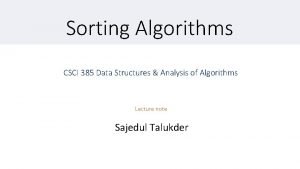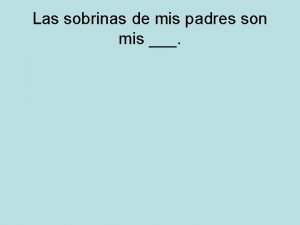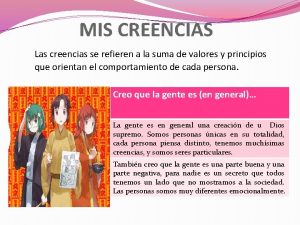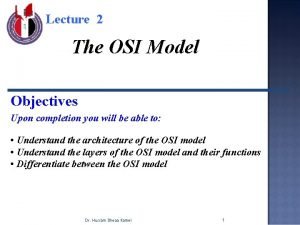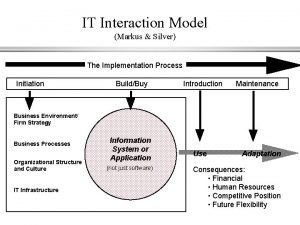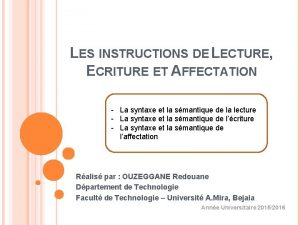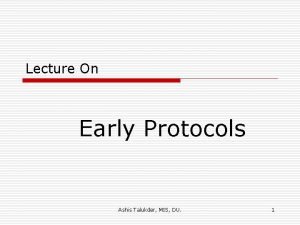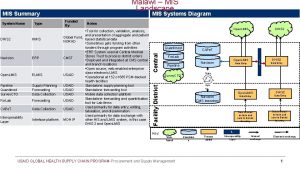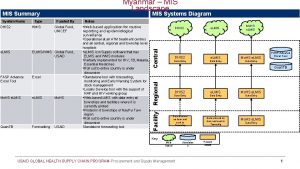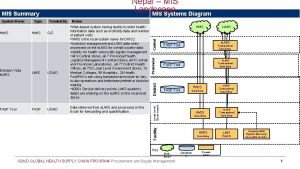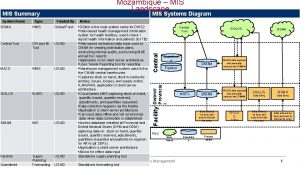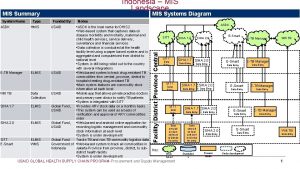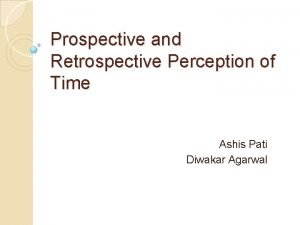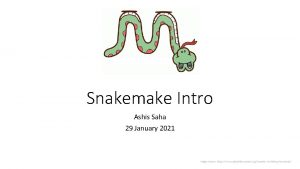Lecture Protocol Model Ashis Talukder MIS EWU 1








































- Slides: 40

Lecture Protocol & Model Ashis Talukder, MIS, EWU. 1

Last Class Ashis Talukder, MIS, EWU. 2

Network Topology n n n n Definition Classification: BUS TREE STAR RING MESH HYBRID Ashis Talukder, MIS, EWU. 3

Today’s Class Ashis Talukder, MIS, EWU. 4

Protocol & Protocol Models n Introduction: Protocol n OSI Model n TCP/IP Model Ashis Talukder, MIS, EWU. 5

Protocol o Protocol is defined as a set of rules that governs the exchange of data between two entities. o Key elements of a protocol: n Syntax: data format n Semantics: control info & error handling n Timing: speed matching & sequencing Ashis Talukder, MIS, EWU. 6

Protocol Models n Open System Interface (OSI) Model n Transmission Control Protocol/Internet Protocol (TCP/IP) Model Ashis Talukder, MIS, EWU. 7

OSI model o To address the problem of network incompatibility, the International Organization for Standardization (ISO) researched networking models like o Digital Equipment Corporation net (DECnet), o Systems Network Architecture (SNA), and o TCP/IP o Proposed a generally applicable set of rules for all networks. o Using this research, the ISO created a network model that helps vendors create networks that are compatible with other networks. Ashis Talukder, MIS, EWU. 8

OSI model o The Open System Interconnection (OSI) reference model released in 1984 was the descriptive network model that the ISO created. o It provided vendors with a set of standards that ensured greater compatibility and interoperability among various network technologies produced by companies around the world. Ashis Talukder, MIS, EWU. 9

OSI Reference Model o has become the primary model for network communications. o Although there are other models in existence, most network vendors relate their products to the OSI reference model. o This is especially true when they want to educate users on the use of their products. o It is considered the best tool available for teaching people about sending and receiving data on a network. o It provided vendors with a set of standards that ensured greater compatibility and interoperability among various network technologies produced by companies around the world. Ashis Talukder, MIS, EWU. 10

Layers of OSI model o o o o Physical Layer Data Link layer Network Layer Transport Layer Session layer Presentation layer Application layer Ashis Talukder, MIS, EWU. 11

Benefits of OSI Models Ashis Talukder, MIS, EWU. 12

Physical Layer o encoding/decoding of signals o preamble generation/removal o bit transmission/ reception o transmission medium and topology Ashis Talukder, MIS, EWU. 13

Physical Layer o Four Specifications: n n Electrical Mechanical Functional Procedural o Devices: n Repeater n NIC n Hub Ashis Talukder, MIS, EWU. 14

Data Link Layer o Logical Link Control n interface to higher levels n flow and error control o Media Access Control n on transmit assemble data into frame n on receive disassemble frame n govern access to transmission medium n for same LLC, may have several MAC options Ashis Talukder, MIS, EWU. 15

Data Link Layer o where n central o greater control, single point of failure n distributed o more complex, but more redundant o how n synchronous o capacity dedicated to connection, not optimal n asynchronous o in response to demand Ashis Talukder, MIS, EWU. 16

Data Link Layer o Devices n n Bridge Switch Ashis Talukder, MIS, EWU. 17

Data Link Layer o o o round robin n each station given turn to transmit data reservation n divide medium into slots n good for stream traffic contention n all stations contend for time n good for bursty traffic n simple to implement n tends to collapse under heavy load Ashis Talukder, MIS, EWU. 18

Network Layer Ashis Talukder, MIS, EWU. 19

Network Layer o o o o Non reliable Best Effort delivery Provide logical addressing (IP address) No error correction Host-to-host Connectivity Routing n Selecting the best path n Forward the packet through that path Device: Router Ashis Talukder, MIS, EWU. 20

Transport Layer o encapsulation o Segmentation and reassembly o connection control n Establish n Maintain n terminate o ordered delivery o flow control o error control n Detection n recovery Ashis Talukder, MIS, EWU. 21

Transport Layer o Addressing n Port Address n Handle Multiple Conversation o Reliable transmission n Sends acknowledgements o Also provide connectionless stream data transmission (UDP) Ashis Talukder, MIS, EWU. 22

Session Layer o o Dialogue Discipline n Simplex n Half Duplex n Full Duplex Establish, manage & maintain session between applications Ashis Talukder, MIS, EWU. 23

Presentation Layer o o Compress/Decompress Data Structure Ensure readable/usable format Data format Ashis Talukder, MIS, EWU. 24

Application Layer o provide support for user applications Ashis Talukder, MIS, EWU. 25

TCP/IP Model Ashis Talukder, MIS, EWU. 26

TCP/IP Protocol Model o The U. S. Department of Defense (Do. D) created the TCP/IP reference model because it wanted a network that could survive any conditions. o Some of the layers in the TCP/IP model have the same name as layers in the OSI model. Ashis Talukder, MIS, EWU. 27

Network Access Layer o The network access layer is concerned with all of the issues that an IP packet requires to actually make a physical link to the network media. o It includes the LAN and WAN technology details, and all the details contained in the OSI physical and data link layers. Ashis Talukder, MIS, EWU. 28

Internet Layer o The purpose of the Internet layer is n to send packets from a network node and n to have them arrive at the destination node independent of the path taken. Ashis Talukder, MIS, EWU. 29

Transport Layer o Segmenting upperlayer application data o Establishing end-toend operations o Sending segments from one end host to another end host o Ensuring data reliability o Providing flow control Ashis Talukder, MIS, EWU. 30

Application Layer o Handles high-level protocols, issues of representation, encoding, and dialog control. o The TCP/IP protocol suite combines all application related issues into one layer and ensures this data is properly packaged before passing it on to the next layer. Ashis Talukder, MIS, EWU. 31

Peer-to-peer Communication Ashis Talukder, MIS, EWU. 32

Peer-to-peer Communication Ashis Talukder, MIS, EWU. 33

Comparison of OSI & TCP/IP model o Similarities include: n Both have layers. n Both have application layers, n n n though they include very different services. Both have comparable transport and network layers. Both models need to be known by networking professionals. Both assume packets are switched. This means that individual packets may take different paths to reach the same destination. This is contrasted with circuit-switched networks where all the packets take the same path. Ashis Talukder, MIS, EWU. 34

Comparison of OSI & TCP/IP model o Dissimilarities include: n n TCP/IP combines the presentation and session layer issues into its application layer. TCP/IP combines the OSI data link and physical layers into the network access layer. TCP/IP appears simpler because it has fewer layers. TCP/IP protocols are the standards around which the Internet developed, so the TCP/IP model gains credibility just because of its protocols. In contrast, networks are not usually built on the OSI protocol, even though the OSI model is used as a guide. Ashis Talukder, MIS, EWU. 35

Advantage of Layered Approach o It breaks network communication into smaller, more manageable parts. o It standardizes network components to allow multiple vendor development and support. o It allows different types of network hardware and software to communicate with each other. o It prevents changes in one layer from affecting other layers. o It divides network communication into smaller parts to make learning it easier to understand. Ashis Talukder, MIS, EWU. 36

…? ? ? Ashis Talukder, MIS, EWU. 37

Next Class Ashis Talukder, MIS, EWU. 38

Early Protocl o Early Protocols: n n ALOHA Slotted ALOHA CSMA/CD o Ethernet: n 10 BASE n 1000 BASE Ashis Talukder, MIS, EWU. 39

Thank You…!!! Ashis Talukder, MIS, EWU. 40
 Shreela talukder
Shreela talukder Sajedul talukder
Sajedul talukder Bus 172 nsu
Bus 172 nsu Ewu bd
Ewu bd Ewu library database
Ewu library database Ewu caar
Ewu caar 01:640:244 lecture notes - lecture 15: plat, idah, farad
01:640:244 lecture notes - lecture 15: plat, idah, farad Proyecto de vida principios
Proyecto de vida principios El hijo de mi tío es mi ___
El hijo de mi tío es mi ___ Mis mai a mis tachwedd
Mis mai a mis tachwedd Mis mai a mis tachwedd
Mis mai a mis tachwedd Cuales son mis creencias
Cuales son mis creencias Osi model lecture
Osi model lecture It interaction model in mis
It interaction model in mis Chicago multiple nuclei model
Chicago multiple nuclei model Project procurement management lecture notes
Project procurement management lecture notes Lecture about sport
Lecture about sport Healthy lifestyle wrap up lecture
Healthy lifestyle wrap up lecture Existentialism vs nihilism
Existentialism vs nihilism Meaning of this
Meaning of this Randy pausch the last lecture summary
Randy pausch the last lecture summary Tensorflow lecture
Tensorflow lecture Theology proper lecture notes
Theology proper lecture notes Strategic management lecture
Strategic management lecture Geology lecture series
Geology lecture series Social psychology lecture
Social psychology lecture In text citation for a lecture
In text citation for a lecture Advantages of government accounting
Advantages of government accounting 4 ps of project management
4 ps of project management Practical design to eurocode 2 lecture 3
Practical design to eurocode 2 lecture 3 Magnetism
Magnetism Classical mechanics
Classical mechanics Physics 101 lecture
Physics 101 lecture Physical science lecture notes
Physical science lecture notes Power system dynamics and stability lecture notes
Power system dynamics and stability lecture notes Natural language processing
Natural language processing Microbial physiology and metabolism lecture notes
Microbial physiology and metabolism lecture notes Mechatronics lecture notes
Mechatronics lecture notes Limits fits and tolerances
Limits fits and tolerances Les objectifs de la lecture
Les objectifs de la lecture Instruction de lecture
Instruction de lecture

